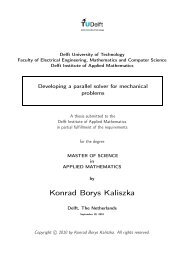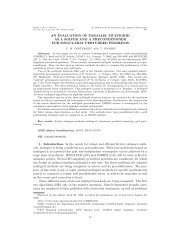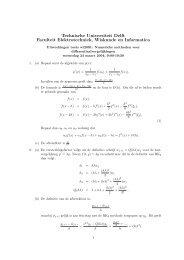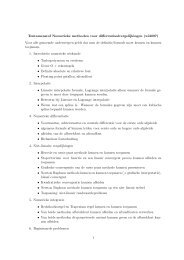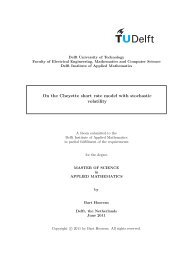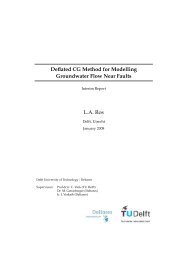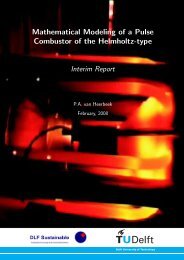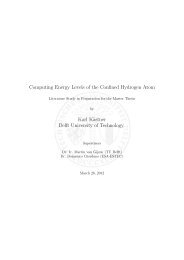Quantitative Finance, Vol. 12, No. 1, January 2012, 89–105<strong>Extension</strong> <strong>of</strong> <strong>stochastic</strong> <strong>volatility</strong> equity <strong>models</strong> <strong>with</strong>the <strong>Hull</strong>–<strong>White</strong> <strong>interest</strong> <strong>rate</strong> processLECH A. GRZELAK*yz, CORNELIS W. OOSTERLEEyx and SACHA VAN WEERENzDownloaded by [Lech A. Grzelak] at 10:55 24 January 20121. IntroductionyDelft Institute <strong>of</strong> Applied Mathematics, Delft University <strong>of</strong> Technology,Mekelweg 4, 2628 CD Delft, The NetherlandszDerivatives Research and Validation Group, Rabobank, Jaarbeursplein 22,3521 AP Utrecht, The NetherlandsxCWI, National Research Institute for Mathematics and Computer Science,Kruislaan 413, 1098 SJ Amsterdam, The Netherlands(Received 28 July 2008; in final form 6 July 2009)We present an extension <strong>of</strong> <strong>stochastic</strong> <strong>volatility</strong> equity <strong>models</strong> by a <strong>stochastic</strong> <strong>Hull</strong>–<strong>White</strong><strong>interest</strong> <strong>rate</strong> component while assuming non-zero correlations between the underlyingprocesses. We place these systems <strong>of</strong> <strong>stochastic</strong> differential equations in the class <strong>of</strong> affinejump-diffusion–linear quadratic jump-diffusion processes so that the pricing <strong>of</strong> Europeanproducts can be efficiently performed <strong>with</strong>in the Fourier cosine expansion pricing framework.We compare the new <strong>stochastic</strong> <strong>volatility</strong> Scho¨bel–Zhu–<strong>Hull</strong>–<strong>White</strong> hybrid model <strong>with</strong> aHeston–<strong>Hull</strong>–<strong>White</strong> model, and also apply the <strong>models</strong> to price hybrid structured derivativesthat combine the equity and <strong>interest</strong> <strong>rate</strong> asset classes.Keywords: Finance; Financial applications; Mathematical finance; Financial derivatives;Financial econometrics; Financial engineering; Mathematical <strong>models</strong>; Financial mathematicsIn recent years the financial world has focused on theaccu<strong>rate</strong> pricing <strong>of</strong> exotic and hybrid products that arebased on a combination <strong>of</strong> underlyings from differentasset classes. In this paper we therefore present a flexiblemulti-factor <strong>stochastic</strong> <strong>volatility</strong> (SV) model that includesthe term structure <strong>of</strong> the <strong>stochastic</strong> <strong>interest</strong> <strong>rate</strong>s (IR). Ouraim is to combine an arbitrage-free <strong>Hull</strong>–<strong>White</strong> IR modelin which the parameters are consistent <strong>with</strong> market prices<strong>of</strong> caps and swaptions. In order to perform efficientoption valuation we fit this process in the class <strong>of</strong> affinejump-diffusion (AJD) processes (Duffie et al. 2000)(although jump processes are not included in this work).We specify under which conditions such a general modelcan fall in the class <strong>of</strong> AJD processes.A major step away from the assumption <strong>of</strong> constant<strong>volatility</strong> in derivatives pricing was made by <strong>Hull</strong> and<strong>White</strong> (1990), Stein and Stein (1991) and Heston (1993),who defined the <strong>volatility</strong> as a diffusion process.This improved the pricing <strong>of</strong> derivatives under*Corresponding author. Email: l.a.grzelak@tudelft.nlheavy-tailed return distributions significantly and alloweda trader to quantify the uncertainty in the pricing.Stochastic <strong>volatility</strong> <strong>models</strong> have become popular forderivative pricing and hedging (see, for example, Fouqueet al. 2000), however financial engineers have developedmore complex exotic products that additionally requirethe modeling <strong>of</strong> a <strong>stochastic</strong> <strong>interest</strong> <strong>rate</strong> component. Aderivative pricing tool in which all these features areexplicitly modeled may have the potential <strong>of</strong> generatingmore accu<strong>rate</strong> option prices for hybrid products. Theseproducts can be designed to provide capital or incomeprotection, diversification for portfolios and customizedsolutions for both institutional and retail markets.Fang and Oosterlee (2008a) developed a highly efficientalternative pricing method based on a Fourier-cosineexpansion <strong>of</strong> the density function and called it the COSmethod. This method can also determine a whole set <strong>of</strong>option prices in one computation. The COS algorithmrelies heavily on the availability <strong>of</strong> the characteristicfunction <strong>of</strong> the price process, which is guaranteed if westay <strong>with</strong>in the AJD class (Duffie et al. 2000, Lewis 2001,Lee 2004). We examine the effect <strong>of</strong> correlated processesfor assets, <strong>stochastic</strong> <strong>volatility</strong> and <strong>interest</strong> <strong>rate</strong>s on optionQuantitative FinanceISSN 1469–7688 print/ISSN 1469–7696 online ß 2012 Taylor & Francishttp://www.tandfonline.comhttp://dx.doi.org/10.1080/14697680903170809
90 L. A. Grzelak et al.Downloaded by [Lech A. Grzelak] at 10:55 24 January 2012prices through a comparison <strong>with</strong>, for example, the in which the squared <strong>volatility</strong>, v t ¼ t 2 , represents theHeston model.variance <strong>of</strong> the instantaneous stock return.pdS t ¼ rS t dt þffiffiffiffi v tStdW x t ,The dimension <strong>of</strong> the (complex-valued) ODEs for B(u, )dv t ¼ 2 v t þ t þ 2 dt þ 2ffiffiffifficorresponds to the dimension <strong>of</strong> the state vector, X t .pv t dWt2Typically, multi-factor <strong>models</strong>, such as the SZHW andthe HHW <strong>models</strong>, provide a better fit to the observedThe plan <strong>of</strong> the paper is as follows. In section 2 weperform an analysis <strong>of</strong> the Scho¨bel–Zhu–<strong>Hull</strong>–<strong>White</strong>model. In subsection 2.3 we show that the hybrid model<strong>of</strong> <strong>interest</strong> admits a semi-closed form for the characteristicfunction. In the following subsection we derive theIt has already been reported by Heston (1993) andScho¨bel and Zhu (1999) that the plain Scho¨bel–Zhumodel is a particular case <strong>of</strong> the original Heston model.We can see that if ¼ 0, the Scho¨bel–Zhu model equalsthe Heston model in which H ¼ 2, H ¼ 2 =2, andHeston–<strong>Hull</strong>–<strong>White</strong> model <strong>with</strong> non-zero correlation H ¼ 2. This relation gives a direct connection betweenbetween the stock and the <strong>interest</strong> <strong>rate</strong>. In section 3 weshow how to efficiently price options <strong>with</strong> a Fouriercosinetheir discounted characteristic functions (Lord and Kahl2006). Finally, if we set r t constant and p ¼ 0 in the systemexpansion technique when the characteristic <strong>of</strong> equations (1), and zero correlations, the modelfunction <strong>with</strong> <strong>stochastic</strong> <strong>interest</strong> <strong>rate</strong> <strong>of</strong> the asset processis available. Further, in section 4 the two hybrid <strong>models</strong>,Scho¨bel–Zhu–<strong>Hull</strong>–<strong>White</strong> and Heston–<strong>Hull</strong>–<strong>White</strong>, andthe <strong>stochastic</strong> <strong>volatility</strong> Heston model are compared indetail <strong>with</strong> respect to calibration and hybrid productpricing. Section 5 concludes. The lengthy pro<strong>of</strong>s <strong>of</strong> thecollapses to the standard Black–Scholes model.We will choose the parameters <strong>of</strong> equations (1) suchthat we deal <strong>with</strong> the Scho¨bel–Zhu–<strong>Hull</strong>–<strong>White</strong> (SZHW)model in subsection 2.3, and <strong>with</strong> the Heston–<strong>Hull</strong>–<strong>White</strong>(HHW) model in subsection 2.4. Gaspar (2004) andCheng and Scaillet (2007) showed that the so-calledlemmas are given in the appendices.linear-quadratic jump-diffusion (LQJD) <strong>models</strong> areequivalent to the AJD <strong>models</strong> <strong>with</strong> an augmented statevector.2. <strong>Extension</strong> <strong>of</strong> <strong>stochastic</strong> <strong>volatility</strong> equity <strong>models</strong>2.1. Affine jump-diffusion processesIn this section we present a hybrid <strong>stochastic</strong> <strong>volatility</strong>The AJD class refers to a fixed probability space (, F, P)equity model that includes a <strong>stochastic</strong> <strong>interest</strong> <strong>rate</strong>and a Markovian n-dimensional affine process X t in someprocess. In particular, we add to the SV model the wellknown<strong>Hull</strong>–<strong>White</strong> <strong>stochastic</strong> <strong>interest</strong> <strong>rate</strong> process (<strong>Hull</strong>space D R n . The model <strong>with</strong>out jumps can be expressedby the following <strong>stochastic</strong> differential form:and <strong>White</strong> 1996), which is a generalization <strong>of</strong> the Vasˇicˇek(1977) model.dX t ¼ ðX t Þdt þ ðX t ÞdW t ,We consider a three-dimensional system <strong>of</strong> <strong>stochastic</strong> where W t is a F t -standard Brownian motion in R n , (X t ):differential equations <strong>of</strong> the formD ! R n , (X t ):D ! R nn . Moreover, for processes indS t ¼ r t S t dt þ t p S t dWt x ,the AJD class it is assumed that drift (X t ), <strong>volatility</strong>dr t ¼ ð t r t Þdt þ dWt r (X t )(X t ) T and <strong>interest</strong> <strong>rate</strong> component r(X t ) are <strong>of</strong> theaffine form, i.e.d t ¼ ð t Þdt þ t1 p dW t , ð1Þ ðX t Þ¼a 0 þ a 1 X t , for any ða 0 , a 1 Þ2R n R nn , ð5Þwhere p is an exponent, and control the speed <strong>of</strong>mean reversion, represents the <strong>interest</strong> <strong>rate</strong> <strong>volatility</strong>, ðX t ÞðX t Þ T ¼ðc 0 Þ ij þðc 1 Þ T ij X t, for arbitraryand 1 p determines the variance <strong>of</strong> the t process.Parameters and t are the long-run mean <strong>of</strong> theðc 0 , c 1 Þ2R nn R nnn , ð6Þ<strong>volatility</strong> and the <strong>interest</strong> <strong>rate</strong> processes, respectively.W i are correlated Wiener processes, also governed byrðX t Þ¼r 0 þ r T 1 X t, for ðr 0 , r 1 Þ2R R n : ð7Þan instantaneous covariance matrix,Then, for a state vector, X t , the discounted characteristic23function (CF) is <strong>of</strong> the following form:1 x, x,rR67T ¼ 4 ,x 1 ,r 5dt:ð2Þ ðu, X t , t, T Þ¼E Q rðes dsþiu T X Tt jF t Þ¼e Aðu, ÞþBT ðu, ÞX t, r,x r, 1where the expectation is taken under the risk-neutralIf we keep r t deterministic and p ¼ 1/2, we have the measure, Q. For a time lag, :¼ T t, the coefficientsHeston (1993) model,A(u, ) and B T (u, ) have to satisfy certain complex-valuedpdS t ¼ rS t dt þffiffiffiffi tStdW x t ,ordinary differential equations (ODEs) (Duffie et al.d t ¼ H ð H t Þdt þ H p ffiffiffiffi2000): t dWt : ð3ÞdFor p ¼ 1, our model is, in fact, the generalized Stein–d Aðu, Þ ¼ r 0 þ B T a 0 þ 1 2 BT c 0 B,Stein (Stein and Stein 1991) model, which is also calleddthe Scho¨bel–Zhu (Scho¨bel and Zhu 1999) model,d Bðu, Þ ¼ r 1 þ a T 1 B þ 1 ð8Þ2 BT c 1 B:




